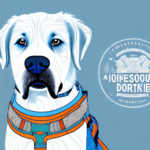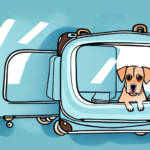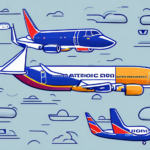If you are planning to travel with your dog, it is important to know and understand United Airlines’ dog policy. United Airlines offers a range of options for traveling with dogs, including in-cabin transport, checked baggage transport, and cargo transport. As a responsible pet owner, it is your responsibility to comply with United Airlines’ policies and prepare your dog for the journey. Below, we will provide an overview of United Airlines’ dog policy, and provide tips on preparing your canine companion for travel.
Overview of United Airlines’ Dog Policy
Traveling with your furry friend can be a fun and exciting experience, but it is important to understand the various policies and requirements that United Airlines has in place for traveling with pets. United Airlines is one of the most popular airlines for pet travel, and they have specific policies and requirements in place for dogs traveling as carry-on, checked baggage, or cargo.
Before you book your dog’s reservation, it is important to do your research and understand the specific policies and requirements for your dog’s travel. Here is an in-depth overview of United Airlines’ dog policy:
In-cabin Pet Policy
United Airlines allows dogs and cats to travel in the cabin on most flights within the United States, as well as select international flights. This is a great option for small dogs that can fit comfortably in an airline-approved carrier that can fit under the seat in front of you.
However, there are certain restrictions and requirements that must be met. Firstly, your dog must be able to fit in an airline-approved carrier that can fit under the seat in front of you. Secondly, you will need to pay a fee for your dog’s transport.
It is important to note that only one pet is allowed per passenger, and the total number of pets allowed on a flight is also limited. You will need to make a reservation for your pet before your flight, and provide required documentation such as a health certificate. United Airlines also provides specific breed restrictions for in-cabin travel, so it is important to double-check with United Airlines before booking a reservation.
If you are traveling with your dog for the first time, it is important to prepare them for the journey. You can do this by gradually introducing them to their carrier before the flight, and providing them with familiar items such as blankets or toys to make them feel more comfortable.
Checked Baggage Pet Policy
If your dog is too large to fit in a carrier that can fit under the seat in front of you, United Airlines also offers checked baggage transport for pets. This is a great option for larger dogs that need more space to travel comfortably.
Dogs must be at least 16 weeks old to be eligible for checked transport, and they also need to be able to stand up, turn around, and lie down in a carrier without touching any of the sides. It is important to note that checked baggage transport is not available on all flights, so you will need to check with United Airlines prior to booking your reservation.
Similar to in-cabin travel, you will also need to provide a health certificate for your dog, and there are specific breed restrictions in place for checked baggage travel. It is important to prepare your dog for the journey by gradually introducing them to their carrier before the flight, and providing them with familiar items such as blankets or toys to make them feel more comfortable.
Cargo Pet Policy
For larger dogs or those that cannot travel in the cabin or as checked baggage, United Airlines also offers transport via cargo. This is a great option for dogs that need more space to travel comfortably, or for dogs that are not able to travel in the cabin or as checked baggage.
United Airlines works with specialist pet transportation agents to ensure that your dog will be transported safely and comfortably. Similarly, there are specific requirements and documentation that are necessary for cargo transport, including special handling fees. It is important to note that there may be breed restrictions for cargo transport depending on the country you are traveling to. Make sure to check with United Airlines for the most up-to-date requirements.
It is important to prepare your dog for the journey by gradually introducing them to their carrier before the flight, and providing them with familiar items such as blankets or toys to make them feel more comfortable. You may also want to consider booking a direct flight to reduce the amount of time your dog spends in transit.
Service and Emotional Support Animals
United Airlines also has policies in place for service and emotional support animals. Service animals are trained to perform specific tasks for individuals with disabilities, and they are allowed to travel in the cabin at no additional cost. Emotional support animals provide emotional support to individuals with mental health conditions, and they may also be allowed to travel in the cabin with the proper documentation.
However, United Airlines has specific requirements and documentation that must be met for both service and emotional support animals. In addition, recent changes to United Airlines’ policies may require additional documentation and longer processing times, so it is important to check with United Airlines for the most up-to-date information.
Overall, United Airlines is a great option for traveling with your furry friend. By understanding the specific policies and requirements for your dog’s travel, you can ensure that your dog has a safe and comfortable journey.
Preparing for Travel with Your Dog
Traveling with your furry friend can be an exciting adventure, but it requires careful planning and preparation. Here are some additional tips to make sure your dog’s journey is as comfortable and stress-free as possible.
Booking Your Dog’s Reservation
Once you understand United Airlines’ dog policy, the next step is to book your dog’s reservation. It is important to note that not all flights allow pets, so make sure to check with the airline before booking your own ticket. It is also recommended to book your dog’s reservation as early as possible, as the number of pets allowed on a flight is limited and can fill up quickly.
When booking your dog’s reservation, make sure to provide all the necessary information, such as your dog’s breed, age, and weight. You will also need to provide the required documentation, such as a health certificate, and pay any necessary fees. It is important to double-check all the requirements before your flight to avoid any last-minute surprises.
Required Health Certificates and Documentation
Before your dog can travel with United Airlines, you will need to provide a health certificate from your veterinarian. This certificate should confirm that your dog is healthy and up-to-date on all vaccinations. It is important to note that United Airlines may have specific requirements for health certificates depending on the destination you are traveling to, so make sure to double-check before your flight.
In addition to the health certificate, you may also need to provide other documentation, such as proof of ownership or vaccination records. Make sure to check with the airline beforehand to avoid any issues at the airport.
Choosing the Right Carrier or Crate
When traveling with your dog in-cabin or as checked baggage, it is important to choose the right carrier or crate. Your dog should have enough space to stand up, turn around, and lie down comfortably. The carrier or crate should also be sturdy and well-ventilated.
For in-cabin transport, make sure to choose an airline-approved carrier that will fit under the seat in front of you. Soft-sided carriers are often a good choice as they are lightweight and easy to maneuver. For checked baggage transport, make sure to choose a carrier that meets United Airlines’ requirements for size, weight, and ventilation.
Preparing Your Dog for the Flight
Finally, it is important to prepare your dog for the flight. This may include gradually acclimating them to their carrier or crate, and making sure they are comfortable spending time in it. You can do this by leaving the carrier or crate out in the open and encouraging your dog to explore it on their own.
It may also include adjusting their feeding schedule to prevent accidents during the flight, and making sure they have plenty of water and food for the duration of the journey. You may also want to pack some of your dog’s favorite toys or blankets to make them feel more at home.
Overall, traveling with your dog requires careful planning and preparation. By following these tips and taking the necessary precautions, you can ensure that your furry friend has a safe and comfortable journey.
Fees and Charges for Traveling with Your Dog
Traveling with your furry friend can be a wonderful experience, but it’s important to be aware of the fees and charges associated with pet transport. United Airlines offers several options for traveling with your dog, including in-cabin, checked baggage, and cargo transport. Each option has its own fees and charges, which we will explore in more detail below.
In-cabin Pet Fees
If you choose to bring your dog with you in the cabin, United Airlines charges a fee for this service. The fee varies depending on the destination and length of the flight, so it’s important to double-check with United Airlines for the most up-to-date fee information. However, the peace of mind that comes with having your furry friend right by your side during the flight can be well worth the cost.
Checked Baggage Pet Fees
If you prefer to have your dog travel as checked baggage, United Airlines also offers this option. The fee for checked baggage transport is based on the weight of your dog and the distance of your flight. Again, fees may vary depending on the destination and other factors, so it is important to check with United Airlines for the most accurate and up-to-date information. However, this can be a good option if your dog is too large to travel in the cabin or if you prefer not to have them with you during the flight.
Cargo Pet Fees
For larger dogs or for those who prefer to travel in a cargo hold, United Airlines offers cargo transport services. The fees for this service vary depending on the size and weight of your dog, as well as the destination. However, United Airlines works with specialist pet transportation agents to provide the best possible care for your canine companion during their journey. This can be a good option for larger dogs who may be more comfortable in a cargo hold than in the cabin or as checked baggage.
Additional Charges and Taxes
It’s important to note that there may be additional charges and taxes associated with traveling with your dog on United Airlines. These may include customs and import fees, as well as taxes related to animal transport. Make sure to check with United Airlines and other relevant authorities for the most up-to-date fee information. Additionally, some destinations may require specific vaccinations or health certificates for your dog, so it’s important to research these requirements well in advance of your travel date.
Overall, traveling with your dog can be a wonderful experience, and United Airlines offers several options for making sure your furry friend arrives safely and comfortably at your destination. With a little planning and research, you can ensure that your pet transport experience is as stress-free as possible.
Conclusion
Traveling with your dog can be a great experience for both you and your furry friend, but it is important to make sure you are prepared and understand United Airlines’ dog policy. Whether your dog is traveling in-cabin, as checked baggage, or via cargo, there are specific requirements and policies that you must comply with. By following these policies and guidelines, you can ensure a safe and comfortable journey for your four-legged friend.






Leave a Reply